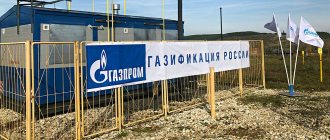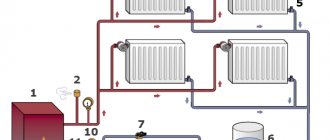Connecting gas to a private home is the key to comfort and coziness. Without high-quality heating, heating a private house in winter is quite problematic, and a gas boiler is rightfully considered one of the most reliable and economical solutions. Even if gasifying a house will cost a tidy sum, it is not worth saving on this, since in most cases the benefits compared to alternative heat sources are obvious even with superficial calculations. In addition, gas is one of the most convenient energy carriers. It is very convenient to cook food on a gas stove, and the boiler will quickly and efficiently warm up the house.
Next, we will consider when and how to properly supply gas to a private home, what the prices for the work are and other nuances. We asked specialists from ROSAVTONOMGAZ, a company that is one of the leaders in the autonomous gasification market, to tell us about all the details of gasification of a private house.
A gas stove and boiler are one of the most effective devices for cooking and heating a home Source szgaz.ru
What can gas supply be like?
It is possible to provide a private home with “blue fuel” according to two schemes.
- Connection to the gas main. If there is a gas pipeline along the street on which the house is located, then you can contact the appropriate service and they will draw up a project for you and carry out the connection. The easiest way to find out where to go is to ask your neighbors who have already been supplied with gas. You can also walk along the pipe and find the distribution station - usually the phone numbers of the service company are written on it. As a last resort, you can call the 104 service, but it is better to first ask your neighbors for the required number;
- But there are places where connecting to the gas main is impossible. These are mainly remote villages and dachas located away from the central villages (for example, on the shore of a reservoir). But even in this case, there is a way out - these are gas tanks. Systems designed to store relatively small gas reserves (from 2,500 m3 to 20,000 m3). These systems provide a residential building with gas year-round; you only need to replenish the reserves of “blue fuel” 1-2 times a year. Many specialized companies have already opened that will help you correctly calculate the volume of a gas tank, prepare permits, and install it in the right place.
On a note! You can get professional advice on autonomous gasification of a private home directly from specialists
Gasification scheme for a private house using a gas holder Source pt.decorexpro.com
Maintenance and cleaning
When heating a bathhouse with birch or pine wood, a large amount of unburnt resinous substances accumulates in the chimney. The soot deposit gradually increases, blocking the lumen of the pipe. Some of the soot may fall to the junction of the horizontal and vertical parts, causing a complete blockage of the pipe.
Contamination cannot be seen from the outside. They are judged by the reduction in draft and the entry of smoke into the room when the firebox door is opened. You can clean the pipe using a special device.
A round brush with hard plastic bristles and a weight (0.5-1 kg) must be attached to a strong rope or steel cable. Lower the device into the upper hole of the vertical part and move it down, performing forward and backward movements. In this case, the soot is swept off the walls with a brush. The flakes fall into the lower part of the tee, from where they can be easily removed along with the accumulated condensate. Soot is removed from the horizontal part of the pipe through special doors if it is long. You can remove dirt from the short pipe directly through the firebox.
To ensure that less soot accumulates in the pipe, it is better to heat the sauna stove with aspen or poplar wood. In addition to removing soot, you need to periodically remove the plug from the tee on the outer pipe and drain the accumulated condensate from it.
Gasification of a private or country house - where to start
The first thing you need to start with gas supply to a private home is technical documentation. You need to contact the appropriate authority that deals with such issues in the area. A special commission will determine the condition of the tenant and the possibility of carrying out installation work. After this, specialists will develop a project, it will be approved by the permitting authority, and workers of the gas industry or a company that has permission for such work will begin the connection process. Before the project is developed, they will only be able to tell you approximately the cost of connecting gas to a private home, since the final price of materials and services consists of many components.
If there is already a gas main near the house, then you will only have to pay for the connection to the pipe - otherwise, the cost of the project most often also includes work on laying the line along the street Source sovetclub.ru
See also: Contacts of companies that deal with engineering systems.
Fire safety
What should you pay special attention to when installing gas heating in a wooden house?
What do the fire safety instructions require?
- The boiler is mounted exclusively on a fire-protected surface. A typical solution is a sheet of galvanized steel with an asbestos backing. At the same time, both the stand for the floor-standing boiler and the substrate for the wall-mounted one must overlap its dimensions by at least 10 cm in all directions.
Galvanization protects a wooden wall from excessive heat.
- The minimum horizontal distance from the boiler or gas convector to other gas or electrical appliances is at least 30 cm. Installation of wiring or any electrical appliances above a gas convector is extremely undesirable: hot air will inevitably render the insulation unusable over time.
- The chimney of a gas boiler must have a diameter no less than the pipe on the boiler, and no more than three bends. The cross-section is only round. The best material is stainless steel.
- A larger opening is made in the wall or roof for the chimney. Gas combustion products leave the boiler relatively cold, but additional insulation from the walls with asbestos or a piece of asbestos-cement pipe is needed. The same applies to coaxial pipes of a gas convector.
- A separate room with an area of at least 4 m2 with a door at least 80 cm wide and a window is allocated for a gas boiler.
- The chimney must be at least half a meter higher than the roof.
Combustion products will not heat the roof leaving the chimney
What documents will be required
It must be remembered that some documents must be ready before installation work begins, and some can be completed during the process, therefore, if it is not possible to complete all the documentation at once, then you need to determine priorities in advance.
Here is a list of documents that must be submitted to the relevant authority in order to be allowed to supply gas to a private home:
- Application in writing. This will begin the preparatory work (analysis of the area, building, etc.);
- Provide copies of documents that identify the customer (the originals must be presented with copies);
- Provide copies of documents that confirm the right to own the house (also present the originals for comparison with copies);
- If the gas pipeline runs through the neighbors’ area, their consent will be required;
Subsequently, she will need documents for the equipment that will be connected to the gas, and the results of a chimney inspection.
You can collect and provide all the necessary documents yourself, or entrust this to other persons by issuing an appropriate power of attorney for them.
Connection diagram is one of the required documents Source premium-gaz.ru
Gas heater. Flaws in work
Next, you should deal with the disadvantages of convectors. The main disadvantage of such a device is that you have to break through the wall to complete the installation. Moreover, a hole is needed here for the coaxial gas outlet, which is a special tube in the pipe through which exhaust gases exit. The fresh air required for combustion is supplied to the convector thanks to an external pipe. It can be assumed that the hole in the wall may be located in a certain area where the convector itself will be placed. If they are located under every window of every room, then there will be a lot of holes in the walls, and they cannot be hidden or placed in one area. In addition, additional space must be made in the wall for the gas supply.
Gas convector installation diagram.
If a standard heating system is used in a living room with an area of 30 square meters with two windows, almost under each window it would be worth installing one convector. However, with gas convectors this option is unacceptable. Here you should install one convector with increased power in a certain area on the outer wall of the room (where there are the most optimal conditions for supplying gas and creating a discharge for exhaust gases). This installation does not imply creating a temperature balance in the room. One corner will be quite hot, and the other will be cold. To create proper comfort, one low-power convector should be placed under each window. However, here the question of price arises, which will double, although the aesthetics of the room will increase. Hence the conclusion - the installation of this heating option will be in many ways inferior to a standard water heating system.
The gas convector includes low inertia. In other words, it heats up quite quickly and cools down at a similar interval. This feature can be attributed to both pros and cons. It all depends on how the device is used. Using it in a residential area can negatively affect the comfort of the temperature regime, but installing it in a garage, barn or workshop will undoubtedly give positive results.
Another nuance in the operation of a gas convector, which can also be considered a plus and a minus, is the presence of a combustion chamber, where the gas heats the chamber, which subsequently heats the air. For the durability of the convector, its design must contain steel that is resistant to fading. It’s good if the device is equipped with just this type of specialized steel (however, the price of the device will double). If the convector uses cheap steel, then it runs the risk of failing very quickly due to corrosion, burnout and other factors. If the combustion chamber in the convector is created using 10 mm cast iron, then the service of the device will be durable.
How to make a home gas supply plan (gasification project)
A gas supply project for a private home is a necessary component for starting all work. Gas-consuming installations are potential sources of danger and compliance with safety regulations is required.
To draw up the correct gas supply plan for your home, specialists need to thoroughly know all the points of the regulatory documents and strictly follow them. The technical department of the gas industry always checks the compliance of the plan with the requirements of regulatory documents and, if necessary, returns them for revision.
The requirements that gas utilities place on projects may vary depending on the terrain, installation method, and installation conditions. It may take several weeks or even months to thoroughly test the plan.
Projects must be strictly individual; plans that were developed for other houses are prohibited from being used by law, and criminal liability is provided for this.
The project must indicate the layout of the house and the location of gas equipment Source encyclopedi.ru
The stages of connecting gas to a private house will vary in each specific case, as they depend on the topography of the site and individual features of the gasification plan.
Features of the solution
Why is this particular combination - gas heating and a wooden house - given such close attention?
Of course, it's a matter of fire safety. The gas is explosive; in addition, during combustion it heats some elements of the boiler or convector to significant temperatures .
If so, we will pay close attention to the rules for the safe installation of gas heating in a private country house.
What else can be said about the features of a wooden house?
- Typical floors in it are boards, plywood or OSB, laid over joists lying on beams . Obviously, a water heated floor system cannot be installed here. They fit into a screed, and placing it on a movable base is clearly a bad idea.
- The walls of a house made of logs or timber provide excellent thermal insulation . The main source of cold in the house is window and doorways. Therefore, it suggests the placement of heating devices under the windows, where they will provide a thermal curtain.
Useful: to be fair, more heat escapes through the roof of a wooden house than through the windows. The insulation of ceilings and attics should also be taken very seriously; however, consideration of roof insulation methods will clearly go beyond the scope of our article.
- Wood is easy to process . Therefore, it will not be difficult to stretch pipes or remove air ducts.
How a gas pipeline is built (connecting a gas line to a house)
With an approved project, you must contact a company that deals with similar work (necessarily with a state license). If the estimate drawn up by the company suits both parties, then an agreement is concluded to carry out the relevant work.
The contract must indicate that the final payment will be made only after all work has been completed and accepted by the official commission.
Upon completion of installation work, as-built production and technical documentation is drawn up, which must be approved by the commission. After successfully connecting the gas line to the house, you can immediately conclude an agreement for the installation of the equipment that will be connected (boiler, stove, etc.).
Commissioning work should be carried out exclusively by gas specialists Source gasworld.ru
Completion of gasification (gas connection to the house) is also an important stage
At the final stage of gasification of the house, all that remains is to undergo training on the safe use of gas equipment, conduct a test run, and conclude an agreement for seasonal maintenance of the system. If a gas tank is installed, then it is necessary to conclude an agreement for systematic gas supplies.
The final “touch” is to give the design documentation (or an approved copy) for safekeeping in the archive, in case redevelopment is later required or any clarifications are required.
What has changed in the rules for gasification of a private home?
Until 2016, it was quite difficult to even roughly predict how much it would cost to connect gas to a private home, since there was no legislative regulation and control. This led to the fact that monopolists could independently set the timing of gasification and its cost. But, with the adoption of new laws, the maximum period for gasification was limited to one and a half years.
It is difficult to name the specific amount that all the work will cost without a ready-made project, but at least the price bracket has been fixed at 20-50 thousand rubles for bringing the gas pipeline to the site, plus installation work inside it.
The cost and timing of approval and implementation of a private home gasification project are now regulated by law. This means that the party ordering the services can now take a more active role in monitoring the work and demand that it be completed on time.











